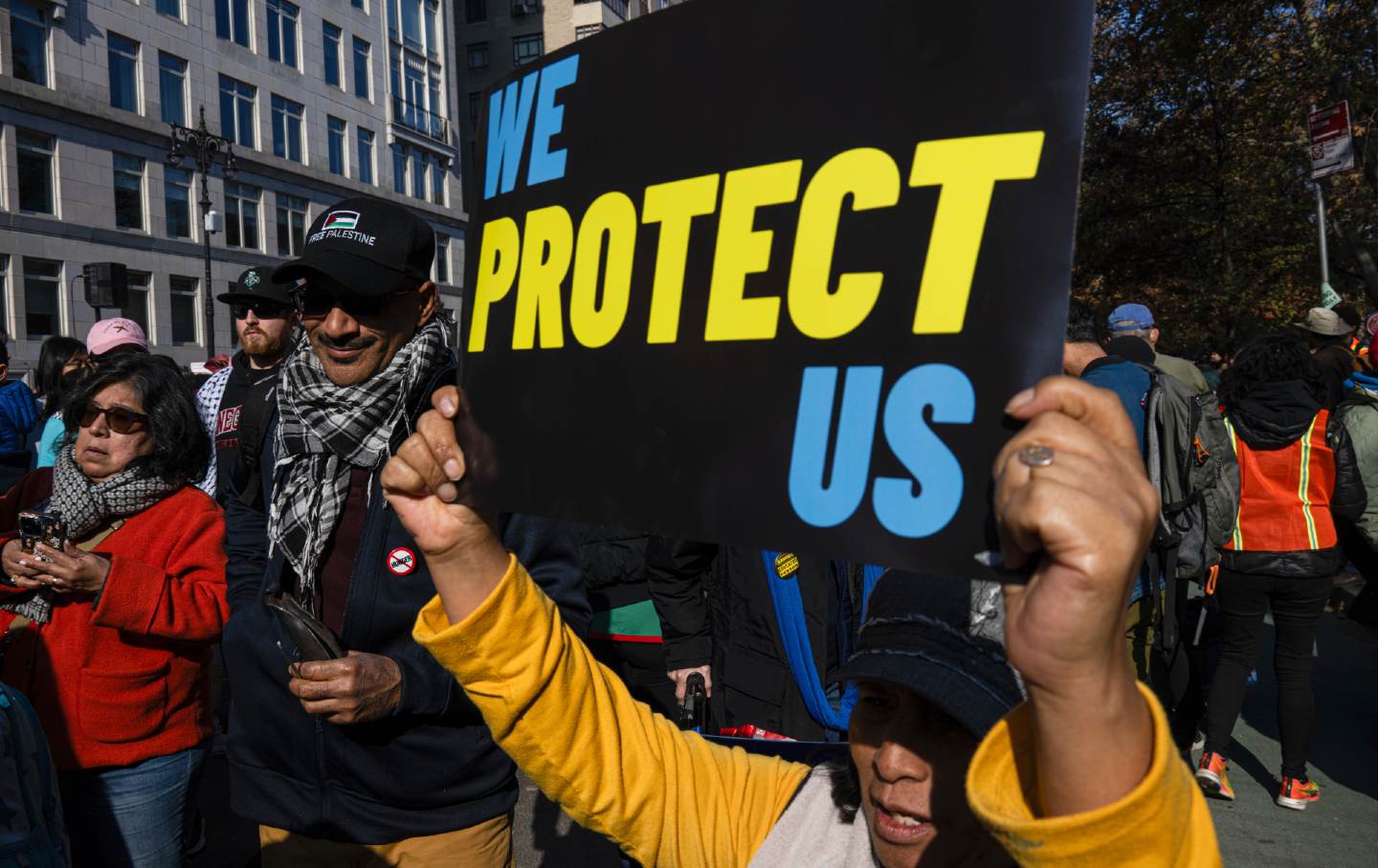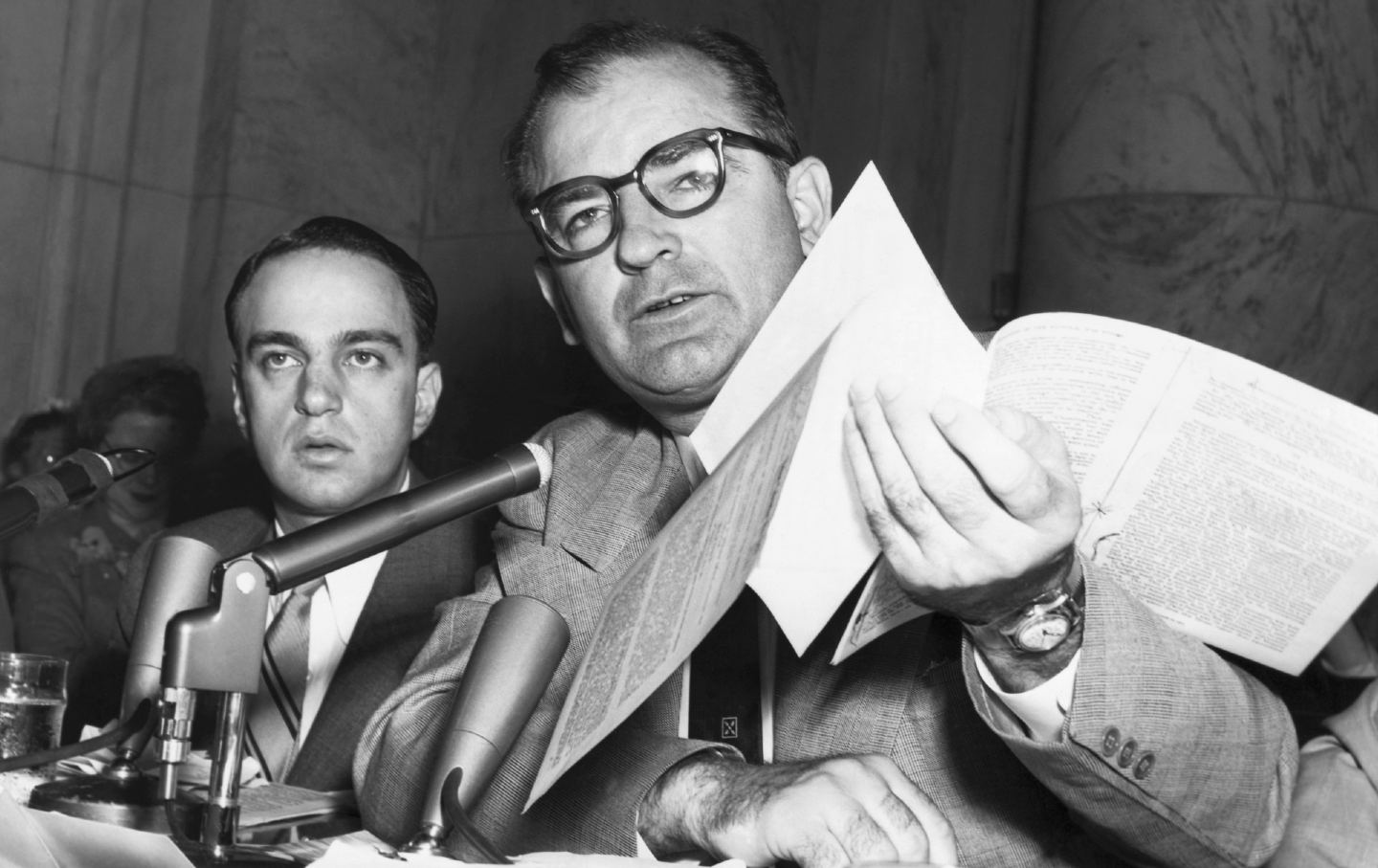Where Do We Go From Here?
Thinkers, activists, and writers share their ideas on how to respond to the coming Trump era.

Pennsylvania, one of the swingiest swing states, is also the mushroom capital of the world. Our back roads are dotted with windowless concrete blocks you could be forgiven for thinking are meth labs—but are actually tanning beds for fungus. Mycelium, the miraculously adaptive living network of tiny, branching, interwoven filaments that bloom into mushrooms in those grow houses and in the woods, form a life-sustaining network for water, nutrients, and communication between trees. Without it, many ecosystems would collapse.
In recent years, the activist and writer adrienne maree brown has begun calling for what she refers to as “mycelial organizing,” inspired by the natural wisdom of mushrooms. It’s a handy metaphor to guide us through the near future.
The resistance now emerging against fascism in the United States will be, like all mass movements, a messy conglomeration of people and organizations doing what they think is the next right thing. Scrappy little groups full of passionate intensity will spring up like, well, mushrooms, while established organizations pivot to sometimes contradictory strategies and the Democratic Party works on messaging. We are about to be hosed with appeals to support all these groups, and we have to choose what to do and with whom.
My own priorities steer me toward organizations like Pennsylvania Stands Up that are fighting for working people, pushing for public policies that speak to their material reality, and using elections to organize around a vision of justice and shared prosperity. This is my jam, but it’s not the only worthwhile one, and no single idea is the right answer forever. If you’re a teacher, teach our nation’s true history, plus how we’ve won in the past; we’re going to require a lot of political education, including those movement memories, or else we’re doomed to keep starting over, and we don’t have that kind of time. If you are a healer, give good care. Artists, please make art; and if you’re funny, make us laugh, because we need that, too.
Put your nose down in the dirt and understand that each of us can be a tiny filament in the vast, complex, dynamic web that will make up the resistance. Find your task and your team, and step into your place in the network, where your assignment is to connect, cooperate, and serve.
For most of us, it’s not our job to come up with the best strategies. Indeed, if we’re privileged, it must not be our job. Now is the time to take direction from people most affected by the new regime (they’ve had it with your bright ideas), to be curious about each other’s lived experiences—and willing to align ourselves with people even if we share only a belief in our common humanity. This is how we build the resistance and reconstitute our nation: by stitching together the social fabric one nuanced relationship at a time, our little threads waving at each other in the dark, blocking and building, sharing resources, warning each other of danger, and protecting those who need protecting.
—Jane Palmer, founding member of PA Stands Up
This past summer, Hurricane Debby broke dams around the country and triggered extreme flooding in five states. Flooding and tornadoes in Iowa destroyed or damaged 5,000 homes. In New Mexico, mudslides and flash floods carried houses down sewage streams, tearing away bridges.
We are living in a latter-day version of Bruce Springsteen’s “My Oklahoma Home”:
It blowed away, it blowed away
All the crops I have planted blowed away
Well, you can’t grow any grain
If you ain’t got any rain
All except my mortgage blowed away
This election revealed the pent-up anger over lost lives and presaged more disasters to come, since the unbearably high costs of housing and healthcare aren’t going down, while low wages and a torrent of highly speculative crypto wipe out people’s savings.
So what do we do now? What would it take to actually stop the disasters—and not just put a thumb in the dam?
In the wake of Donald Trump’s first election, many elite Democrats, holding hands with disaffected Republicans, put Trump and Trumpism at the center of their politics, casting him in the role of the seducing serpent, and the seduced in the role of deplorables, or un-Americans. This supposedly made anti-Trumpism a pro-democracy movement—regardless of its other commitments—and allowed “pro-democracy” to mean anything anti-Trump, including, for example, a Federal Election Commission petition to allow greater coordination between super PACs and candidates, and a lawsuit to allow foreign money to be spent on domestic ballot-measure campaigns. In each of those cases, the goal was to defeat Trump, so reducing the power of the voter was deemed justified. Democrats also embraced any big corporation that stood up to Trump, whether it was Disney or Meta or Google; any institution standing up to Trump must have been a force for good. All those strategies failed—catastrophically.
Now we need to build a real democracy movement. That means throwing out the deference toward big donors and the hope of a more genteel brand of oligarchy. It means investing in actual democratic institutions, such as responsive state parties. It means public funding for local elections, passing laws against foreign money in elections and corporate super PAC coordination, and replicating efforts like Maine’s new limit of $5,000 on contributions to any super PAC. It means constantly fighting to tear down our corrupt big-money campaign finance system—however hard that may be—and no longer pretending it is compatible with democracy.
And it means recognizing that anti-monopoly is at the heart of any democracy movement. As Justice Louis Brandeis said, “We can have democracy in this country, or we can have great wealth concentrated in the hands of a few, but we can’t have both.”
Economic populism needs to be at the heart of the Democratic Party going forward—not because it sounds nice, but because meaningful human freedom requires economic freedom too. That can’t happen if we keep trying to build a tent big enough to include tech oligarchs and private equity. They will always knock it down.
—Zephyr Teachout, constitutional lawyer and scholar
Imagine that we needed to fix a crisis in our public schools, and somebody proposed hiring a bunch of consultants to take over the schools and build a network of disconnected after-school programs. We would think that was as absurd as it was counterproductive.
Well, instead of schools, think state parties. The consultants are the DC-based strategists who orbit the Democratic Party, and the after-school programs are the endless PACs and groups that start up during an election cycle and usually close after that cycle is complete, leaving no lasting infrastructure for the next set of candidates and volunteers.
Now is the time to dispense with that tired approach and to listen instead to the movement and party leaders in the states, who are most connected to the voters—but whose expertise is all too often dismissed.
State parties are the only entities that exist to build the party and elect Democrats year-round no matter who is in the White House. And yet, instead of funding the smart and dedicated leaders who are connected to their communities, we parachute in teams of consultants and staff who live in our states for a few months and then promptly leave.
Fortunately, this problem has a solution. And no, it is not to burn down the Democratic National Committee. We need a DNC chair who “gets” the grassroots, has run a state party, knows how to fundraise, can craft a budget to match Democratic goals and values (rather than perpetuate the party’s dependence on corporate donors and dark money), and can manage a team to accomplish the massive goal of winning back the millions of voters who agree with us on the issues but have turned away from our party’s brand and candidates. The DNC chair controls the budget, the primary schedule for 2028, and the rules governing how decisions get made on everything from messaging to targets. When we lose the White House, we actually get to elect the next DNC chair. So now we have this one moment to get it right—to transform the way we operate as a party.
State parties currently account for roughly 8 percent of the DNC budget. While Tom Perez, who ran the DNC during Trump’s first term, and Jaime Harrison, who ran it during Biden’s tenure, made some notable improvements—creating a red state fund, increasing funding for state parties (with those in red states getting extra), and radically diminishing the power of superdelegates—we need to do much more. State parties, especially in presidential and congressional races, are often seen as little more than a bank account, when they could be the core of our electoral program, messaging, and strategy.
Democrats can win elections in every single state. But only if we elect a DNC chair who believes in state parties—and is prepared to make the fundamental changes that must happen on the inside before we can start winning again.
—Jane Fleming Kleeb, Nebraska Democratic Party chair
Trump has already started to renege on some of the more outlandish campaign promises he made to get reelected, but there’s no reason to believe his administration will back down on immigration. Though the Department of Homeland Security lacks the resources and manpower to deport the estimated 13 million undocumented immigrants living in the country—or even the comparatively tame 1 million per year suggested by Vice President–elect JD Vance—it’s undeniable that Trump and his allies will do everything in their power to ramp up the arrest, detention, and removal of noncitizens, undocumented or otherwise.
Popular
“swipe left below to view more authors”Swipe →They’ve been preparing for this moment for almost four years. The America First Policy Institute, a right-wing think tank with ties to the Trump campaign, has already drafted executive orders for Trump to sign. And with some of the same hard-liners by his side who oversaw the cruelest policies of his first term—including Stephen Miller and former ICE acting director Tom Homan, who will serve as Trump’s “border czar”—Trump will be able to set some of his most malevolent plans in motion on day one.
Now, as before, immigration advocates are prepared to challenge Trump’s unlawful policies in court, although there will be obstacles. Trump will inherit a friendly Supreme Court and judiciary (during his first term, he appointed an inordinate number of federal judges), creating significant hurdles even for the strongest lawsuits.
Still, there are other ways to fight back, and we don’t have to wait for Trump to take office—the time to act is now. While Biden is still in office, we should push him to do everything in his power to safeguard undocumented immigrants, including ending federal contracts with private ICE detention centers. And although immigration is a federal issue, there is much to be done locally. Most undocumented people end up in deportation proceedings because of contact with the criminal punishment system: By urging local governments to decriminalize certain low-level offenses, we can limit ICE’s reach in our communities.
The most important things we have to offer are our time and solidarity. Most cities have volunteer-led immigrant advocacy groups that will certainly be hungry for new members. Attorneys can offer pro bono services to people in deportation proceedings, who aren’t entitled to free, government-appointed lawyers. People who speak languages other than English can offer to translate immigration paperwork and help people fill out forms. And anyone can accompany undocumented immigrants to ICE check-ins, routine appointments that the agency will likely weaponize during Trump’s second term. Though there’s much to be concerned about, there is no time to despair.
—Gaby Del Valle, immigration reporter
Given that we have a short time to prevent the worst of global warming—the world’s scientists have told us to cut emissions in half by 2030—the election was clarifying in that it cut off a number of possible courses of action. We won’t see new federal legislation, and we’ll probably see a serious challenge to continuing to spend money from the Inflation Reduction Act on clean energy; the courts, already unhelpful, are likely to grow even more so; international negotiations seem unlikely to pressure the Trump administration into acting.
That leaves one thing working in our favor: the precipitous decline in the cost of solar and wind power, and the batteries to store that energy when the sun goes down or the wind drops. It feels as if the main viable path left for climate progress is figuring out how to make the most of the fact that we live on a planet where the cheapest way to generate power is to point a sheet of glass at the sun.
—Bill McKibben, environmentalist and cofounder of 350.org
In every neighborhood across the country, there is a house, an elder, or a family that acts as a community resource. These folks know everyone, look out for everyone, and have the ability to affect how things run on the block. They are also often overlooked by Democratic strategists.
In her sprint to Election Day, Vice President Kamala Harris notched celebrity endorsement after celebrity endorsement: Beyoncé, Taylor Swift, most of the Avengers, and LeBron James—alongside many others—all came out to rally the public against Trump and for Harris. Yet she could not secure 270 Electoral College votes. Why didn’t these high-profile validators matter? The results of the presidential election show, among many other things, that there is a growing disconnect between the influencers who operate at the “grass tops” and the organizers of the grass roots.
There’s a different way to persuade and mobilize—and this way begins with the on-the-ground, progressive community organizations that reach out to people where they are. Call them the true influencers.
Consider groups like Black Leaders Organizing for Communities, a Milwaukee-based organization that knocks on doors year-round and works to build long-term political power. BLOC is on the same side of many issues as the local Democratic Party, but it has different end goals. Its aim, like many community organizations across the country, is to build healthy, thriving neighborhoods. One of its tactics is to help its preferred candidates win elections, including presidential elections—but its members can also be seen at city council meetings, helping neighbors address quality-of-life concerns, and providing political education that enables members to push for their concerns at every level of government. BLOC also demands that local political parties hold the line on important issues and not toss them aside in the pursuit of short-term political gain.
This model of long-term engagement is the way we win.
Organizations like BLOC can be a crucial liaison between voters and the Democratic Party. But for BLOC to remain credible, the party must deliver on the agenda that it asks organizers to sell. Communities are tired of voting for the “lesser of two evils” and deserve the opportunity to vote for something that serves them—not just against something that will harm them.
To bridge this gap, the Democratic Party will need to begin by making a real commitment to building an agenda for working people that addresses the material needs of everyone in our communities. There are many ways to go about this, but An Economy for All: Building a “Black Women Best” Agenda—a plan put forward by the Congressional Caucus on Black Women and Girls that articulates a legislative program that encompasses the economy, democracy, health, and the environment—should serve as a model.
Finally, remember that you have a role to play in how our collective future unfolds. Find a political home and organize. Get to know the people on your block, and you can become a resource. The next four years are going to require dedication, creativity, and solidarity. We need you in the fight.
—Tracey Corder, senior strategist with Synergy Power Consulting and Angela Lang, the executive director of BLOC
If you are committed to achieving reproductive justice, you’re likely used to being disappointed by election results. Reproductive justice demands that we secure for everyone the right to maintain bodily autonomy, to have children, to not have children, and to be able to parent the children we have in safe and sustainable communities. So… we are (and have been) a long way off.
But this moment feels different. Voters reelected Donald Trump, the president who is responsible for the conservative supermajority on the Supreme Court that overturned Roe v. Wade. Trump is now heading back to the White House to inflict even more damage, including, perhaps, enforcing the Comstock Act, which could make it illegal to mail abortion pills. With his administration promising to violently separate migrant and mixed-status families, to eliminate the federal agency protecting students’ civil rights, and to make healthcare unaffordable for the most vulnerable populations, reproductive justice feels unattainable at this moment.
This feels particularly painful given that the election came breathtakingly close to going in the opposite direction. Vice President Kamala Harris ran a campaign in which, for the first time in history, reproductive freedom was a major element of a Democratic presidential nominee’s platform, and the people affected by abortion bans were central to the argument for why we needed to protect and expand access to care. The Harris team even had several women speak at campaign stops about their abortion experiences. For activists who have been working on the front lines to defend abortion access, it was undeniably remarkable to see people who have had abortions spotlighted in this way, and to hear our truths told by party leaders and allies in such clear language.
But the truth is, this was never the radical progress it appeared to be. As We Testify founder Renee Bracey Sherman and I have argued in talks all over the country since the release of our book Liberating Abortion in October, real progress means not merely the right to an abortion—it means abortion liberation. This vision goes beyond begging politicians for crumbs and instead invites everyone to do the work of ending abortion stigma—which for too long has been the air we’ve all breathed—and build a world in which people are supported no matter their reproductive decisions, whether that is to have or to not have children. It means a world in which everyone receives all of the support and resources they need—including paid leave, a living wage, and affordable childcare, to start—to create their families and parent their children in a sustainable way.
What would it look like if we showed up with compassion and love instead of judgment and fear when a loved one tells us they are pregnant and are considering their options? How can we step up and support people no matter their decision, knowing that the majority of people who have abortions already are parents? That might look like offering to babysit for loved ones who need a multiday procedure, or spreading the gospel of abortion funds to all who will listen, or sharing your story when the topic comes up in conversation to normalize what is a quite normal procedure. What if, instead of falling into the trap of despair that the right wants us to succumb to, we doubled down on our commitment to ending abortion stigma in every possible way while demanding reproductive justice for all? We were never going to find liberation through an election, whether Harris won or not. But what if I told you that we can liberate abortion no matter who is in power, because the “power” is ours, if we choose to demand it?
—Regina Mahone, senior editor at The Nation
As Bernie Sanders has said, we need a Democratic Party centered on working class power and prosperity. Working Americans without a college degree—Black, brown, and white—are the voting majority, and a potential unifying force in our nation. Yet we now face unprecedented divisiveness and the greatest economic inequality in 100 years.
Democratic Party reform should focus on grassroots party building, organizing across our 3000 counties, and building coalitions with unaffiliated voters. Counties are the building blocks of the electoral process, and we can incentivize registration and turnout. Party reform should also include discussion of how the 57 state and territorial Democratic parties can keep dark money out of their nominating process. The Supreme Court deregulated general election expenditures in its Citizens United ruling, but the state parties have every right to regulate their own nominating process.
We should celebrate the explosion in union organizing, including thousands of workers in tech, journalism, manufacturing (at Volkswagen and other plants in the South), as well as at universities, in health care, and in the public sector. We should remember the big strikes that led to breakthrough contracts in the auto industry, at Boeing, and at AT&T—and the contract mobilization campaigns at UPS and many others.
In the private sector, the role of the National Labor Relations Board has been essential, despite the worst federal judiciary in decades, the largest wealth gap in a century and the lowest level of collective bargaining coverage of any global democracy.
But all too often we ignore the connection between organizing at work and political action—or even worse, argue about their relative importance. In this moment we should remember that Jennifer Abruzzo, an NLRB General Counsel appointed by Biden, and barely confirmed by the Senate, has built a staff team that starts each day from the premise that collective action at every workplace, with or without a union, is the essence of the law, and that whenever a majority of workers organize, the Board has an obligation to promote collective bargaining and their right to a first contract.
Why emphasize all this now when so much more that we love is at risk? Because too many, including union activists, will forget too quickly. We must do what we can now to preserve the critical organizing and bargaining lessons of the past few years—and include them in our next outline of the legal reforms worth fighting for in the future.
—Larry Cohen, BoARD CHAIR OF OUR REVOLUTION
In the Texas panhandle city of Amarillo on Election Day, Dexie Organ, 60, stepped out of her beat-up Nissan and headed across the parking lot to vote. On her way, she saw a volunteer holding a sign that read: “Vote No on Prop A.” Organ stopped. “I need a little education,” she told the sign-holder, Diann Anderson, who explained to her that Proposition A was an abortion travel ban that would deputize private citizens to sue anyone they suspected of helping someone travel through Amarillo to get an abortion out of state. “I do believe that is unconstitutional,” Organ told me. Organ told me she has 14 children—and she’s had an abortion. “I have eight daughters…and I want them to have what they want,” she told me.
So Organ went inside and cast her ballot against the ordinance—and in favor of Donald Trump.
A critical mass of voters made this seemingly contradictory choice along with Organ: the same electorate that voted for abortion rights in seven out of the ten states where they were on the ballot also voted to return Trump, the man responsible for overturning Roe v. Wade, to office. Abortion rights ballot initiatives won alongside the most conservative of Republicans, like Senator Josh Hawley in Missouri and Tim Sheehy in Montana. Even in Florida, the high-stakes abortion rights ballot initiative won 57 percent of the vote, making it one point more popular than Trump himself; it failed only because Florida has a 60 percent threshold for an amendment to pass. About 3 in 10 voters in Arizona, Missouri, and Nevada who supported abortion rights ballot measures also voted for Trump. The right to abortion won big this election, yet so did the party that ended that right. Organ saw Trump’s position on abortion as acceptable because “he gave it to the states” – including her state, where abortion is banned. Trump had convinced Organ and perhaps millions like her that he did not pose a threat to their daughters.
But is it any wonder that voters like Dexie Organ felt they had permission to vote for abortion and Republicans? The pro-choice signs I saw at the polling place in Amarillo could have come from the National Rifle Association or the Libertarian Party. “Say no to government overreach,” read one. “Defend our Constitution. Vote against Prop A,” read another. In Missouri, the successful campaign to enshrine a right to abortion until viability in the state constitution was called Missourians for Constitutional Freedom. Floridians Protecting Freedom sought to peg that state’s six-week ban to the unpopular “government overreach” that angered Floridians during COVID. “Do not attack Republicans (including DeSantis or Trump) directly,” internal guidance sent to supporters by the campaign urged. “Instead, refer to ‘extreme politicians’ who banned abortion.”
Campaigns like the one in Amarillo had met voters where they were, allowing them to vote against anti-abortion restrictions in a way that felt consistent with their conservative values. Perhaps, at least here in the Bible Belt, it was the only way to win. Keith Morris, 51, voted against the anti-abortion ordinance and for the libertarian presidential candidate. “A lot of people here have forgotten what being Texan is all about,” he told me. “One thing that being Texan means: You don’t like people in your business, telling you what to do.”
Trump, of course, will now be able to tell us all what to do when it comes to abortion. He could fulfill the promise of Project 2025 and invoke the 1873 Comstock Act to ban the mailing of abortion drugs nationwide, including in the very states that voted to protect abortion rights. He could push for a national abortion ban.
When we look at how we got into this conundrum, one answer is that these campaigns had siloed “reproductive freedom” off the rest of the progressive agenda. They have proven abortion could win in isolation, even in red states, but that these wins will not automatically translate into victories for Democrats. Vice President Kamala Harris failed to articulate a winning economic message that connected reproductive freedom with a sense that Democrats would help struggling people raise the families they did want. There’s no doubt that the referendums protecting the right to abortion, especially in states like Missouri and Arizona that had abortion bans in place, will change thousands of lives. At the same time, it’s clear that Democrats can’t assume that having abortion on the ballot will always raise their fortunes—they need to claim it as part of a broader agenda.
—Amy littlefield, abortion access correspondent








